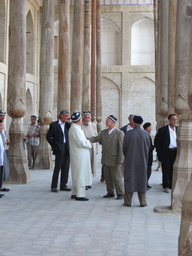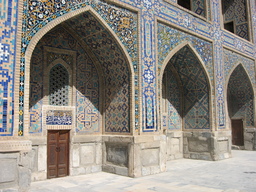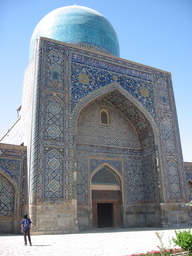
After Evening Prayers
Bolo Hauz Mosque, Bukhara
 After Evening Prayers Bolo Hauz Mosque, Bukhara |
My main reason for coming to Uzbekistan was to visit its ancient cities. To be more precise, I wanted to see the Islamic architecture which endured the centuries and conquerors the region has seen.
I'd heard amazing descriptions of Samarkand, Bukhara, and Khiva. These are all cities with long, well-preserved pasts, yet each also lives on as a modern city today. From the photographs I'd seen, the history I'd read, the accounts I'd heard related by visitors recent and long past--these places sounded like an area where I'd be happy exploring for weeks. I had such high expectations before entering Uzbekistan that I consciously prepared myself to be underwhelmed. Anticipation can skew perception. I worried that maybe I wouldn't be able to accept the merits of what I saw, having imagined the calligraphy, the tilework, the scale of the surviving structures--to be so much more beautiful than they in reality were.
I experienced such a letdown once as a teenager. The first time I visited Paris, my reaction upon seeing the Mona Lisa hanging in the Louvre was, "I've seen better renderings of this picture." Years of build-up had spoilt my perspective. Seeing reproductions so often throughout my life and hearing what a masterpiece the picture was led me to assume that seeing the original would somehow be a fresh experience. It wasn't.
Islamic art is among the things I like most; sites around Uzbekistan have some of the finest monuments ever built. Before setting off for Samarkand, I reminded myself of that first time I saw the Mona Lisa. I prepared myself for the likelihood that those old mosques, tombs, and schools couldn't actually be as incredible as I pictured. "Travel can't always be amazing--some sights are bound to disappoint," I told myself. I didn't want to feel let down, finding that a site I had so long wanted to visit didn't live up to my imagination.
 The Registan, Samarkand |
At the site of Samarkand's Registan several enormous buildings surround a central plaza. On first approach, I felt overwhelmed trying to take it all in--it was too ornate. I started by focusing on the smaller details: the design around a door frame, the lay of the bricks forming the exterior walls. I tried to dissect each design in my mind, figuring how the pieces came together. The composition of the designs seemed simple enough, lots of basic shapes: straight lines, triangles, and hexagons. Simple as the elements seemed, I quickly realized that there would be no way I myself would ever be able to craft such elaborate geometrical patterns, let alone script out such ornate calligraphy. Rendered on a smaller, more manageable scale--say painted on a canvas--these would be lovely works of art. Seeing these designs as patterns inlaid along towers shooting into the sky--it's impossible to describe their impact.
In one instance, Arabic script--white on blue--flows beautifully above a colossal arch. If I myself--just once--created something so beautiful as that line of text, I would consider it a lifetime achievement. However, that calligraphy above the arch is but one minor piece of the ornamentation of the overall facade.
At another point, closer to ground level, a thin slab of stone allows light and air to circulate above a doorway--dozens of hexagons and triangles have been chiseled away. The placement of these vacant polygons relative to each other combines to produce patterns of larger different shapes: stars and circles. As the sun moves across the sky, the shadow cast by this pattern is gradually, beautifully distorted.
The exterior walls surrounding the main structures have bricks laid in special configuration. Placed at angles perpendicular to the rest of the bricks in the wall, certain bricks in just the right places have been brushed with either turquoise- or navy-colored glaze. These colored bricks form a special kind of geometric calligraphy, spelling words which read clockwise within a square. (Most often "Allah" or "Mohammed".)
 Kosuke at the Registan |
I've been accompanied by a new travel companion over this past week. While passing back through Tashkent I met Kosuke, a student from Japan, at the guesthouse we both happened to stay in. We were heading off in the same direction from Tashkent, since meeting we've been sharing double rooms at hotels and bed-and-breakfasts. It's nice to have somebody to chat, explore, and take meals together with for awhile. Sharing the cost of accomodation allows us to upgrade to a higher standard that neither of us would want to spring for if we were traveling independently. After a few days we'll part ways--Kosuke will continue on up to Kazakhstan, I'll return to Tashkent to take care of more paperwork for onward visas.
Where I go from Uzbekistan is still up in the air. Even when submitting paperwork according to procedure--i.e. paying for extra letters of invitation and unreasonably high visa fees--there is still a lot of waiting and uncertainty. If everything comes together I'll have a transit visa to cross Turkmenistan. If my visas don't come together, I'll have to come up with some alternate route west. If I have to, I'll take a flight, though would rather not. Making the entire trip to Europe overland seems the right way to go.
Regardless of what comes next, I have two weeks left on my present visa--my time in Uzbekistan will be up come October 11.